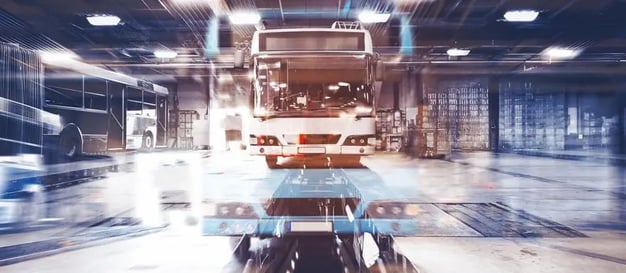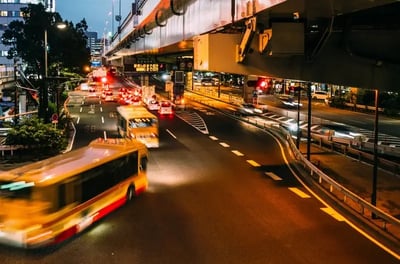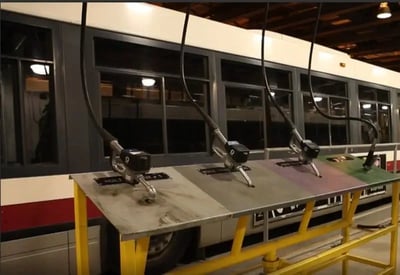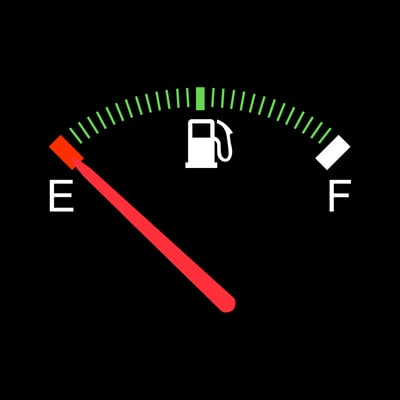
"If the shoe fits, wear it", the saying goes.
But fleet managers of the public transit industry often learn to their chagrin, that the shoe doesn't fit all that well with the generic fleet fuel management systems available in today's market.
Managers have expressed the desire for systems that recognize and address the unique challenges of public transit organizations. In a previous blog about fuel management systems, we briefly touch upon those challenges, but there is much more to say.
So what are these challenges? Read on to find out as we break them down in detail and present elegant, field-tested solutions to them.
Fuel management systems: the basics
Public transit is an integral part of North American life. It’s not just a way to get from point A to point B, but also to reduce fuel consumption and greenhouse gas emissions. Therefore, the public transit industry should be taken seriously as both a fuel-saving measure and a climate change solution. 
But to accomplish their important mission, these fleets are always on the move and thus consume vast volumes of fuel, making fuel management a critical aspect of public transit operations. In light of this, it’s important to have a strong handle on fuel usage to provide more cost-effective service to their ridership.
To be sure, many essential elements of a competent automated fuel management system are the same regardless of the type of commercial or industrial fleet. For further information, see our prior deep dive into the basics of fuel management systems, but some of the most important features are:
- Automatic management of fuel dispensers based on employee and vehicle identified
- Automatic storage tank management using electronic probes
- Restrictions on products dispensed based on vehicle identified
- Single-click fuel inventory reconciliation reports
- Easy integration to third-party systems—anything from accounting to preventive maintenance management to ERP
How is the public transit industry different When It Comes to Fleet Management?
Public transit fleets, on the other hand, have specific operational characteristics that make standard fuel management solutions less than ideal. Let's look at these specificities and how to deal with them to increase fleet efficiency.
Small Service Window
Refuelling tends to occur during highly concentrated time periods.
Aside from the obvious morning and evening commutes, which are quite busy, cities are busier during the day than at night because more people are out and about, tending to work or other obligations. This means that waking hours are the busy hours of public transit bus fleets, thus making the late evening and nighttime the optimal period for servicing buses.
As a result—and particularly in big cities—a large number of buses must often be inspected and refuelled in relatively short, concentrated time periods, stressing human material resources daily.
Solution
A hyper-streamlined process perfectly tailored to public transit operations.
The bus is identified automatically using long-range RFID when it pulls into the fueling bay; all compatible product reels and dispensers are authorized based on its configured profile.
Here we note that, depending on the bus model, the fuel tank can be near the front of the vehicle or at the rear, such that the management system's fuel island terminal (FIT) is sometimes located at the "wrong" end, i.e., away from the bus's fuel tank.
This forces the attendant to walk back and forth along the fueling bay whenever they need to input information (such as vehicle odometer, visual inspection results, or identifying themselves) into the system. To eliminate this inefficiency, the fuel management system allows for two FITs, one at each end of the fueling bay. This way, regardless of the bus's fuel tank location, the attendant is always near one or the other FIT, which operates in tandem and interchangeably to keep the fueling transaction moving smoothly.
Perhaps most significantly, this dual-FIT capability enables a high throughput, two-person workflow, sometimes called "fuel attendant + jockey" mode. In this mode, one attendant remains stationed at the fuel bay while two drivers (or "jockeys") pull in buses one after another into the service bay. The attendant refuels the bus and checks engine oil, transmission fluid, etc., while the jockey performs an inspection, clean up, etc.
Optionally, If the jockey's inspection reveals any minor defects (broken windshield wiper, torn seat, or other), the jockey can key in corresponding defect codes at the FIT to be saved as part of the refuelling transaction for later reporting.
Finally, the fleet manager or shift foreman has the option of setting up any number of free-format messages targeting a specific vehicle or employee. A message will appear on the FIT display whenever the addressed vehicle or employee is identified.
Multiple Fluids per Fueling Transaction
Buses are typically serviced in fuel lanes where fuel is but one of several products dispensed.
The process of in-house fueling in the public transit sector is apart from other commercial/industrial fleets in that fuel (usually diesel) is just one of several products that may be dispensed in a single transaction. Engine oil, brake and transmission fluids, windshield washer and others may all be dispensed as well when a bus is serviced. And for many great reasons—including vehicle preventive maintenance planning—these consumables need to be tracked and managed.
Regrettably, however, traditional fuel management systems can only handle one product at a time per transaction.
As a result, the attendant must go through the tedious procedure of starting and completing a transaction for fuel, as well as separate and additional transactions, one for each extra product (engine oil, baking fluid, etc.) that the vehicle needs. There's got to be a better way to do this.
Solution
An expanded, multi-product refuelling mode that authorizes, measures, and records up to 6 different products within the same single transaction.
As soon as the bus is identified, the system unlocks all the dispensers and reels in the fueling bay, which are compatible according to the vehicle's preconfigured profile (thus preventing human error by ensuring that incompatible fuels, engine oils, etc. remain inaccessible). Authorized products remain accessible throughout the entire fueling procedure. Every ounce dispensed is recorded as part of the same single transaction, available for later reporting or export to accounting, preventive maintenance planning, and other systems.
Out-of-Fuel Buses Are Not an Option
Running out of fuel on the road is catastrophic, both financially and reputationally.
Imagine a city bus running out of fuel somewhere on its route. Now imagine this happening during peak morning rush hour on a busy bridge. Picture the fallout from that scenario: the passengers, the massive gridlock, the towing, and the radio and TV news reports.
A crisis on this scale is not an option for public transit agencies.
Solution
A single-click or automated report listing all vehicles that weren't refuelled during the previous shift will catch these minor issues before they become big problems.
In case a second higher level of security is required, buses can be equipped with an inexpensive Vehicle Data Unit that will issue an alert in real-time if a vehicle takes the road with insufficient fuel in the tank.
Tracking Consumables in the Maintenance Bays
Beyond the fueling lanes, typical public transit facilities will also have maintenance bays (A.K.A. "shop bays") where several fluids are consumed as part of the fleet’s maintenance activities. Failure to track these consumables makes accurate inventory reconciliation virtually impossible and degrades accountability..webp?width=400&height=267&name=transit-bus-maintenance-bay-sm2-fuel-transit%20(1).webp)
Solution
A multi-product arrangement very similar to the one we described for the fueling bays, but with a slightly different transaction sequence, works perfectly here.
The system knows this is a mechanical maintenance bay (through user-configurable settings) and therefore adjusts the transaction sequence to skip those steps specific to refuelling, which is unnecessary here. Lubes and other products dispensed are recorded with accuracy, as well as the vehicle and mechanical technician performing the maintenance tasks.
Since the reels dispensing fluids in the maintenance bays invariably draw from the same storage tanks as those in the fueling bays, this setup supplies the missing puzzle piece needed to complete the inventory reconciliation picture.
But on the preventive maintenance front, you can go further still if you wish.
For data entry, a terminal identical to the one at the fueling bay may be installed or, alternatively, an industrial-grade tablet with a touch screen. The vehicle's complete maintenance history can be displayed—either on the tablet or on a larger, overhead-mounted flat screen—providing the technician with often critical hindsight and insight, such as repeatedly occurring modes of failure on a particular bus, for instance.
Floor Staff and Management Priorities Often Diverge
Unionized floor personnel whose priorities don't always align with those of management.
Public transportation agencies and their employees have traditionally been heavily unionized. Depending on location and an organization's culture, varying degrees of friction will exist between floor staff and management. But even in a best-case scenario, the accurate data that managers need to collect to achieve high levels of efficiency in their fleet is not necessarily foremost in the minds of floor workers.
A regrettable state of affairs that's been the downfall of many expensive management systems by way of GIGO (garbage in, garbage out)..webp?width=400&height=249&name=Workers-talking-to-management%20(1).webp)
Solution
Remove the need for human intervention from the process at every opportunity.
The high throughput requirements in servicing large public transit fleets daily can lead to high-pressure situations. Managers themselves understand that accurate data gathering can easily take a backseat to expediency in the thick of things.
A well-designed fuel management system will unburden floor workers by automating data collection as fully as possible, guaranteeing that the data finding its way into management systems is complete and consistently error-free.
Therefore, the system eliminates the need for keypad data entry wherever feasible. Obviously, the quantities dispensed are measured and recorded automatically (volumetric pulse generators are typically used for this), but we can go much further. A truly capable system will also offer options to:
- Automatically identify the bus as it pulls into the fueling bay using overhead or lane-side long-range RFID
- Effortlessly authenticate fuel attendants and drivers using RFID badges or key-fobs
- Periodically record storage tank levels automatically using electronic tank probes, eliminating the need for manual dipstick measurement of fuel and other consumable inventories.
- Automatically detect and record deliveries of fuel and other consumable fluids using electronic tank probes, to be used, among other things, for single-click inventory reconciliation.
- Automatically detect storage tank leaks and send immediate notifications by email and SMS.
- Capture engine data—odometer, engine hours, idling, fault codes—directly from the vehicle using an always-connected, IoT-style Equipment Tracking Unit or, if recurring per-vehicle costs are to be avoided, a Vehicle Data Unit with drive-by style data collection.
In our experience, this kind of smart automation produces happier floor employees, very pleased managers, and more efficient bus fleets.
What the ideal fuel management system for public transit looks like
But how did Coencorp's SM2-FUEL become so exquisitely adapted to the public transit industry's way of doing things? Because it was designed this way from the ground up.
Fuel management for public transport agencies is how we got our start and established our reputation—and we haven't stopped leading the way since: 30 years and four system generations later, our very first clients are still with us. At this point, SM2-FUEL has more public transit-focused features and functionality than any other system on the market.
Public transit is woven into SM2's DNA
The public transit industry is unique, with a unique set of requirements in its fueling operations. Only a fuel management system that is seamlessly integrated, mature, and has public transit woven into its DNA will enable public transit agencies to reach the greatest levels of efficiency in fuel management.
SM2-FUEL delivers on that front and then some. Contact us today for more information—we believe you'll discover that this shoe really does fit perfectly.
